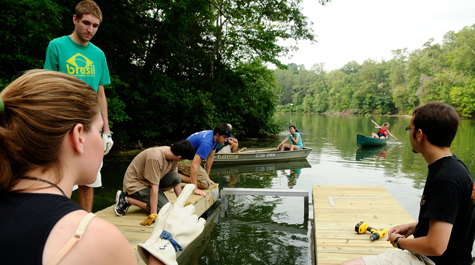W&M receives $500k for biofuel study
The U.S. Department of Energy (DOE) has awarded the College of William and Mary $500,000 to study various aspects of using wild aquatic algae as both biofuel feedstock and as a medium for helping to clean contaminated waterways.
“Basically, it will allow us to continue doing the fundamental research that is crucial for understanding how to make wild algae into biofuels,” said William Cooke, professor of physics at William and Mary. Cooke, along with Dennis Manos, also of physics, will manage the project as co-principal investigators. Cooke explained that the DOE grant will support scientific study that will inform the Chesapeake Algae Project (ChAP).
{{youtube:medium|mi_ZJ9Zaq2E}}
ChAP is an ongoing initiative to establish an industrial-scale facility that can produce various biofuels from algae. ChAP, funded by a $3 million seed grant from the Norwegian energy giant Statoil, is a collaborative effort involving several academic and corporate partners.
Cooke said the DOE grant will fund several avenues of investigation at William & Mary and its Virginia Institute of Marine Science.
Questions to be addressed are:
- How does pulsed water affects algal growth? Cooke and Gene Tracy, the Chancellor Professor of Physics, will examine causes behind a phenomenon noted by fellow ChAP team member Walter Adey of the Smithsonian Institution. In developing his Algal Turf Scrubber, Adey found that, in land-based systems, a pulsed flow of water enhanced growth of the algae. Cooke and Tracy’s team will try both to identify the specific mechanism behind the phenomenon and to determine how to take advantage of it in open-water algal flumes.
- Are algal polycultures more effective at contaminant removal than single-species approaches? Emmett Duffy, the Loretta & Lewis Glucksman Professor of Biological Sciences, and Elizabeth Canuel, professor of physical sciences at VIMS, will compare the relative efficiency of a community of many algal species as compared to an established monoculture of a single form of algae. Duffy and Canuel will continue studies already begun at the land-based floway at the VIMS campus.
- To what degree are the algae processing aquatic contaminants? A VIMS-based team led by Michael Unger, associate professor of environmental and aquatic animal health, will examine the process in which wild algae take up substances such as nutrients and carbon—and also organic contaminants and heavy metals—from the environment. The team, which also will include Canuel, will address the question of whether the algae break down contaminants chemically or just store them internally.
- What’s the best biochemical preprocessing of algae for conversion into biofuel? On William & Mary’s main campus, a team led by Rob Hinkle, associate professor of chemistry, will investigate novel ways to extract lipids and carbohydrates from the algae. The team will include Mark Forsyth, associate professor of biology, and Kurt Williamson, assistant professor of biology, who will investigate the use of bacteria and viruses to break down the hard outer algal cell wall.
The funding also provides for construction and maintenance of algae-cultivation facilities in the form of experimental land-based floways (such as the one at VIMS) and in-water flumes. One such flume is in operation at the College’s Lake Matoaka, where Randy Chambers, the C.B. Talbot Professor of Biology, will help to optimize the algae growth. Another flume will be deployed this fall in the York River near VIMS.
{{youtube:medium|AO9yo0QHsPM}}
















